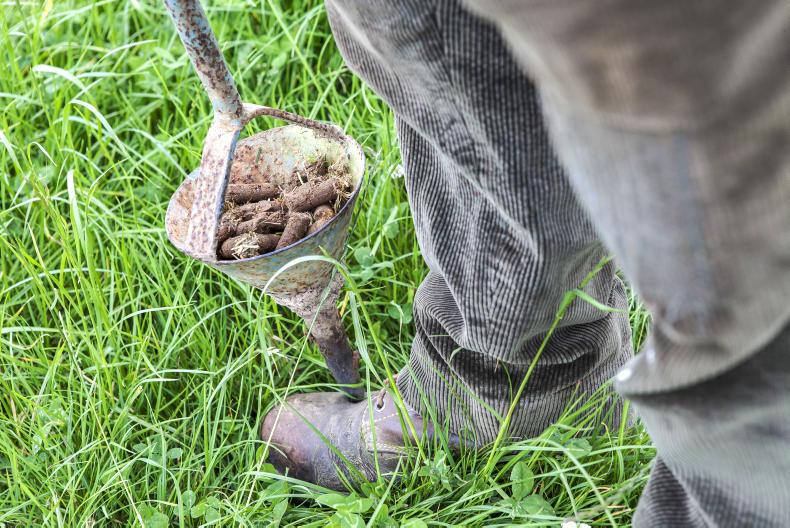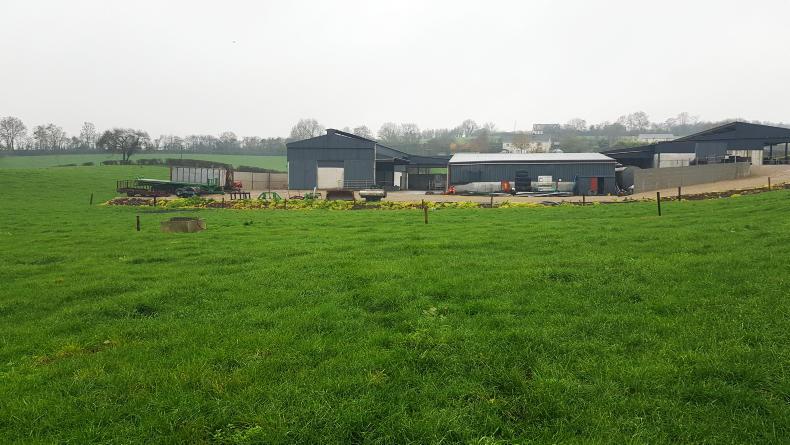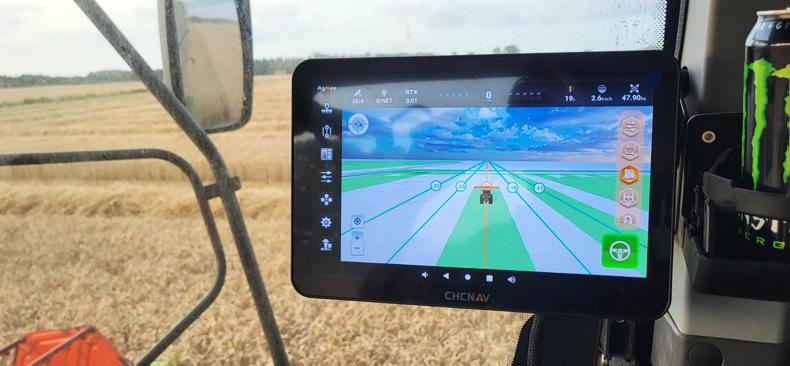Improving soil fertility was a key focus on Dairylink Ireland farms during phase one of the programme.
Addressing deficiencies of phosphorus (P), potassium (K) and lime in soils, as well as better grassland management, led to annual grass yields on phase one farms increasing by 25% on average over three years.
The plan is to take soil samples on phase two Dairylink farms this winter to build an accurate understanding of soil fertility and develop fertiliser plans to address any issues.
This should take place shortly because now is the ideal time to soil-sample as test results will not be affected by recent fertiliser or slurry applications.
In general, the advice is that a soil sample can cover up to 4ha and samples are taken rotationally once every four years. However, on Dairylink Ireland farms, a sample is taken from individual paddocks annually to get a more accurate and up-to-date understanding of soil fertility on programme farms.
Samples are being taken on outlaying land blocks as well as the grazing platform so that soil nutrient status is optimised across all land farmed.
Silage ground has higher P and K requirements than grazing ground and can often have nutrient deficiencies.
The tests used for soil analysis in the Republic of Ireland and Northern Ireland are different and so are the P and K indexes used to interpret results.
Results from Frank Goodman’s farm, outlined in Table 1, are based on the ROI soil test.
In this system, soil index 1 is classified as very low, index 2 is low, index 3 is medium and index 4 is sufficient/excessive. In the NI system, intensive grassland soils with a phosphorus and potassium index 0 and 1 are deficient, index 2- and 2+ are optimal and index 3 and over is above optimal.
Farmer focus: Frank Goodman, Carrickmacross, Co Monaghan
The most recent soil analysis taken on Frank Goodman’s farm near Carrickmacross in March 2018 showed that P and K levels in soils were generally in a good place and the main issue was soil pH.
On Frank’s farm last March, eight samples were taken on the grazing block and each sample covered a 4ha area.
Only two of the eight samples were above pH 6, with the biggest lime requirement of 10t/ha needed on an area with soil pH of 5.4.
The general advice is not to spread more than 2.5t of lime per acre (6.2t/ha) at once as over application of lime can tie up trace elements and K in soils.
Almost all samples showed no deficiency in P or K so fertiliser applications were not needed to build up soil P and K levels.
However, applications were needed on some paddocks to maintain P and K at their optimal levels.
Three of the eight samples had a P index 4 and the recommendation was that further P applications were not needed for maintenance.
Half of the samples analysed at P index 3 and 27 units of P per hectare was recommended on these paddocks for maintenance.
One sample was slightly below optimal for P with an index 2 and 37 units/ha was needed for build-up and maintenance.

A sample will now be taken from individual paddocks annually to get more accurate and up-to-date results.
On the soil K analysis, half of the samples were at index 4, meaning no additional K applications were recommended in these paddocks.
The other half of the samples all analysed at K index 3 and required 45 units of K fertiliser per hectare for maintenance.
Frank’s fertiliser recommendations are for grazing ground only and are based on his milking platform stocking rate of three livestock units per hectare.
Fertilisers
Straight P and K fertilisers such as 18-46-0 and 0-0-60 can be used for addressing deficiencies.
In general, straight P fertilisers should go on in the spring and K fertilisers in the autumn.
However, Dairylink adviser Conail Keown usually recommends that programme farmers apply P and K through a little-and-often approach, particularly if nutrient requirements are for maintenance only.
This is done by including compound fertilisers in the fertiliser programme throughout the grazing season.
Slurry must also be considered, with 1,000 gallons usually equivalent to a bag of 5-5-25.
In Frank’s case, slurry is used on silage ground and any further P and K requirements are met by compound fertiliser applications.
The grazing block on the Goodman farm receives all P and K requirements through compound fertilisers.
Soil sampling on Frank’s farm will be more detailed this winter and will be extended beyond the grazing platform to outlying land blocks.
This will give an understanding of soil fertility on all land farmed and will show how ground lime spread throughout 2018 has addressed soil pH issues on the grazing platform.
Weekly roundup
Soil sampling is taking place on Dairylink Ireland farms this winter.Nutrient management and fertiliser plans will be based on soil analysis results.Breeding is continuing on programme farms this week.Submission rates in weekly table below are the number of cows (or heifers) served out of total cows (or heifers) that were eligible for service. Read more
Controlling costs on Dairylink farms
Watch: switching to a flying herd in Co Antrim
Targeting meal to freshly calved cows
Watch: flag raised for start of breeding season
Improving soil fertility was a key focus on Dairylink Ireland farms during phase one of the programme.
Addressing deficiencies of phosphorus (P), potassium (K) and lime in soils, as well as better grassland management, led to annual grass yields on phase one farms increasing by 25% on average over three years.
The plan is to take soil samples on phase two Dairylink farms this winter to build an accurate understanding of soil fertility and develop fertiliser plans to address any issues.
This should take place shortly because now is the ideal time to soil-sample as test results will not be affected by recent fertiliser or slurry applications.
In general, the advice is that a soil sample can cover up to 4ha and samples are taken rotationally once every four years. However, on Dairylink Ireland farms, a sample is taken from individual paddocks annually to get a more accurate and up-to-date understanding of soil fertility on programme farms.
Samples are being taken on outlaying land blocks as well as the grazing platform so that soil nutrient status is optimised across all land farmed.
Silage ground has higher P and K requirements than grazing ground and can often have nutrient deficiencies.
The tests used for soil analysis in the Republic of Ireland and Northern Ireland are different and so are the P and K indexes used to interpret results.
Results from Frank Goodman’s farm, outlined in Table 1, are based on the ROI soil test.
In this system, soil index 1 is classified as very low, index 2 is low, index 3 is medium and index 4 is sufficient/excessive. In the NI system, intensive grassland soils with a phosphorus and potassium index 0 and 1 are deficient, index 2- and 2+ are optimal and index 3 and over is above optimal.
Farmer focus: Frank Goodman, Carrickmacross, Co Monaghan
The most recent soil analysis taken on Frank Goodman’s farm near Carrickmacross in March 2018 showed that P and K levels in soils were generally in a good place and the main issue was soil pH.
On Frank’s farm last March, eight samples were taken on the grazing block and each sample covered a 4ha area.
Only two of the eight samples were above pH 6, with the biggest lime requirement of 10t/ha needed on an area with soil pH of 5.4.
The general advice is not to spread more than 2.5t of lime per acre (6.2t/ha) at once as over application of lime can tie up trace elements and K in soils.
Almost all samples showed no deficiency in P or K so fertiliser applications were not needed to build up soil P and K levels.
However, applications were needed on some paddocks to maintain P and K at their optimal levels.
Three of the eight samples had a P index 4 and the recommendation was that further P applications were not needed for maintenance.
Half of the samples analysed at P index 3 and 27 units of P per hectare was recommended on these paddocks for maintenance.
One sample was slightly below optimal for P with an index 2 and 37 units/ha was needed for build-up and maintenance.

A sample will now be taken from individual paddocks annually to get more accurate and up-to-date results.
On the soil K analysis, half of the samples were at index 4, meaning no additional K applications were recommended in these paddocks.
The other half of the samples all analysed at K index 3 and required 45 units of K fertiliser per hectare for maintenance.
Frank’s fertiliser recommendations are for grazing ground only and are based on his milking platform stocking rate of three livestock units per hectare.
Fertilisers
Straight P and K fertilisers such as 18-46-0 and 0-0-60 can be used for addressing deficiencies.
In general, straight P fertilisers should go on in the spring and K fertilisers in the autumn.
However, Dairylink adviser Conail Keown usually recommends that programme farmers apply P and K through a little-and-often approach, particularly if nutrient requirements are for maintenance only.
This is done by including compound fertilisers in the fertiliser programme throughout the grazing season.
Slurry must also be considered, with 1,000 gallons usually equivalent to a bag of 5-5-25.
In Frank’s case, slurry is used on silage ground and any further P and K requirements are met by compound fertiliser applications.
The grazing block on the Goodman farm receives all P and K requirements through compound fertilisers.
Soil sampling on Frank’s farm will be more detailed this winter and will be extended beyond the grazing platform to outlying land blocks.
This will give an understanding of soil fertility on all land farmed and will show how ground lime spread throughout 2018 has addressed soil pH issues on the grazing platform.
Weekly roundup
Soil sampling is taking place on Dairylink Ireland farms this winter.Nutrient management and fertiliser plans will be based on soil analysis results.Breeding is continuing on programme farms this week.Submission rates in weekly table below are the number of cows (or heifers) served out of total cows (or heifers) that were eligible for service. Read more
Controlling costs on Dairylink farms
Watch: switching to a flying herd in Co Antrim
Targeting meal to freshly calved cows
Watch: flag raised for start of breeding season











SHARING OPTIONS